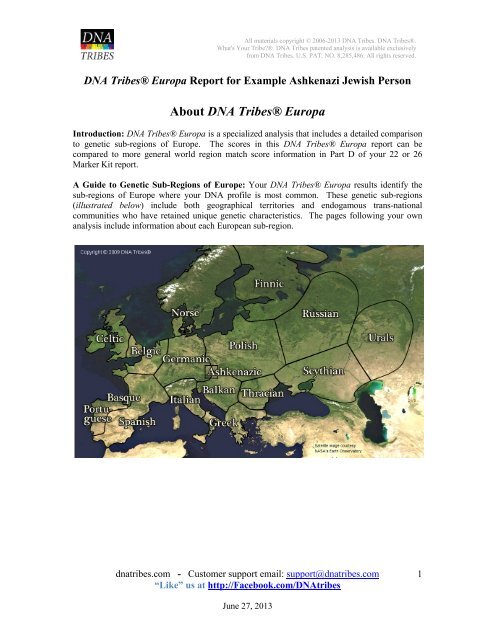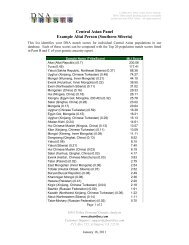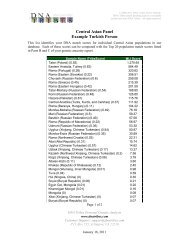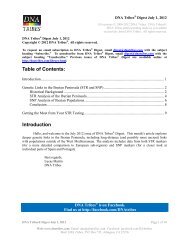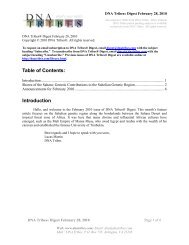About DNA Tribes® Europa
About DNA Tribes® Europa
About DNA Tribes® Europa
You also want an ePaper? Increase the reach of your titles
YUMPU automatically turns print PDFs into web optimized ePapers that Google loves.
All materials copyright © 2006-2013 <strong>DNA</strong> Tribes. <strong>DNA</strong> <strong>Tribes®</strong>.<br />
What's Your Tribe?®. <strong>DNA</strong> Tribes patented analysis is available exclusively<br />
from <strong>DNA</strong> Tribes. U.S. PAT. NO. 8,285,486. All rights reserved.<br />
<strong>DNA</strong> <strong>Tribes®</strong> <strong>Europa</strong> Report for Example Ashkenazi Jewish Person<br />
<strong>About</strong> <strong>DNA</strong> <strong>Tribes®</strong> <strong>Europa</strong><br />
Introduction: <strong>DNA</strong> <strong>Tribes®</strong> <strong>Europa</strong> is a specialized analysis that includes a detailed comparison<br />
to genetic sub-regions of Europe. The scores in this <strong>DNA</strong> <strong>Tribes®</strong> <strong>Europa</strong> report can be<br />
compared to more general world region match score information in Part D of your 22 or 26<br />
Marker Kit report.<br />
A Guide to Genetic Sub-Regions of Europe: Your <strong>DNA</strong> <strong>Tribes®</strong> <strong>Europa</strong> results identify the<br />
sub-regions of Europe where your <strong>DNA</strong> profile is most common. These genetic sub-regions<br />
(illustrated below) include both geographical territories and endogamous trans-national<br />
communities who have retained unique genetic characteristics. The pages following your own<br />
analysis include information about each European sub-region.<br />
dnatribes.com - Customer support email: support@dnatribes.com<br />
“Like” us at http://Facebook.com/<strong>DNA</strong>tribes<br />
1<br />
June 27, 2013
All materials copyright © 2006-2013 <strong>DNA</strong> Tribes. <strong>DNA</strong> <strong>Tribes®</strong>.<br />
What's Your Tribe?®. <strong>DNA</strong> Tribes patented analysis is available exclusively<br />
from <strong>DNA</strong> Tribes. U.S. PAT. NO. 8,285,486. All rights reserved.<br />
<strong>DNA</strong> <strong>Tribes®</strong> <strong>Europa</strong> Report for Example Ashkenazi Jewish Person<br />
Your <strong>DNA</strong> <strong>Tribes®</strong> <strong>Europa</strong> Results<br />
Ashkenazic (0.87)<br />
Greek (0.68)<br />
Italian (0.59)<br />
Spanish (0.4)<br />
Belgic (0.42)<br />
Portuguese (0.41)<br />
Germanic (0.38)<br />
Balkan (0.38)<br />
Thracian (0.41)<br />
Basque (0.24)<br />
Celtic (0.27)<br />
Polish (0.24)<br />
Scythian (0.19)<br />
Norse (0.2)<br />
Russian (0.12)<br />
Urals (0.23)<br />
Finnic (0.04)<br />
898.97<br />
564.20<br />
335.46<br />
306.32<br />
213.27<br />
192.07<br />
172.49<br />
159.56<br />
136.31<br />
91.53<br />
75.08<br />
74.84<br />
54.63<br />
23.45<br />
18.57<br />
3.92<br />
25,511.40<br />
dnatribes.com - Customer support email: support@dnatribes.com<br />
“Like” us at http://Facebook.com/<strong>DNA</strong>tribes<br />
2<br />
June 27, 2013
All materials copyright © 2006-2013 <strong>DNA</strong> Tribes. <strong>DNA</strong> <strong>Tribes®</strong>.<br />
What's Your Tribe?®. <strong>DNA</strong> Tribes patented analysis is available exclusively<br />
from <strong>DNA</strong> Tribes. U.S. PAT. NO. 8,285,486. All rights reserved.<br />
<strong>DNA</strong> <strong>Tribes®</strong> <strong>Europa</strong> Report for Example Ashkenazi Jewish Person<br />
A Guide to the Genetic Sub-Regions of Europe:<br />
Ashkenazic: Ashkenazim (from<br />
the Hebrew word for Germany)<br />
are Jewish Diaspora peoples<br />
historically living as endogamous<br />
communities within Central and<br />
Eastern Europe. Ashkenazi<br />
populations trace their genetic<br />
roots to medieval Jewish<br />
communities along the Rhine<br />
River and ultimately to the Land of<br />
Israel.<br />
Balkan: The Balkan region<br />
includes lands of southeastern<br />
Europe along the Adriatic Sea,<br />
including the rugged mountain<br />
territories of the Dinaric Alps. A<br />
large part of this predominantly<br />
Slavic-speaking area was<br />
previously known as Yugoslavia<br />
(meaning “Land of the South<br />
Slavs”), now divided into several<br />
smaller and independent nations.<br />
Basque: Basques live in historical<br />
lands near the Pyrenees Mountains<br />
and the Bay of Biscay at the<br />
junction of France and Spain.<br />
Basque peoples speak Euskara, a<br />
unique language unrelated to the<br />
Indo-European tongues spoken by<br />
most Europeans, and their<br />
distinctive culture is sometimes<br />
thought to be descended from<br />
traditions maintained in Iberia<br />
since the time of the last Ice Age.<br />
dnatribes.com - Customer support email: support@dnatribes.com<br />
“Like” us at http://Facebook.com/<strong>DNA</strong>tribes<br />
3<br />
June 27, 2013
All materials copyright © 2006-2013 <strong>DNA</strong> Tribes. <strong>DNA</strong> <strong>Tribes®</strong>.<br />
What's Your Tribe?®. <strong>DNA</strong> Tribes patented analysis is available exclusively<br />
from <strong>DNA</strong> Tribes. U.S. PAT. NO. 8,285,486. All rights reserved.<br />
<strong>DNA</strong> <strong>Tribes®</strong> <strong>Europa</strong> Report for Example Ashkenazi Jewish Person<br />
Belgic: The Belgic region includes<br />
the Low Countries of continental<br />
Europe, northern parts of France,<br />
and adjacent populations across the<br />
English Channel in Britain. In the<br />
time of Julius Caesar, these lands<br />
(part of northern Gaul) were<br />
inhabited by the Belgae, whose<br />
culture shared elements with<br />
neighboring Gaulish (Celtic) as<br />
well as Germanic peoples.<br />
Celtic: The Celtic region includes<br />
the historically Celtic-speaking<br />
nations and territories along the<br />
Atlantic façade of Northwestern<br />
Europe. These cultures are known<br />
not only for their unique Indo-<br />
European languages, but also for<br />
forms of art, music, and sport local<br />
to homelands in and near the<br />
British Isles.<br />
Finnic: The Finnic region is the<br />
northernmost region of Europe and<br />
home to Finns, Estonians and<br />
related Scandinavian peoples.<br />
These northern cultures are<br />
distinguished by their Uralic<br />
languages, related to tongues<br />
spoken in Hungary and by some<br />
ethnic groups of Western Siberia.<br />
dnatribes.com - Customer support email: support@dnatribes.com<br />
“Like” us at http://Facebook.com/<strong>DNA</strong>tribes<br />
4<br />
June 27, 2013
All materials copyright © 2006-2013 <strong>DNA</strong> Tribes. <strong>DNA</strong> <strong>Tribes®</strong>.<br />
What's Your Tribe?®. <strong>DNA</strong> Tribes patented analysis is available exclusively<br />
from <strong>DNA</strong> Tribes. U.S. PAT. NO. 8,285,486. All rights reserved.<br />
<strong>DNA</strong> <strong>Tribes®</strong> <strong>Europa</strong> Report for Example Ashkenazi Jewish Person<br />
Germanic: The Germanic region<br />
includes the Germanic speaking<br />
lands of Central Europe. Named<br />
Germania by the Romans, these<br />
centrally located territories are<br />
home to the influential Teutonic<br />
peoples who often came in contact<br />
with nearby regions and were<br />
instrumental in spreading Roman<br />
civilization throughout medieval<br />
Northern Europe.<br />
Greek: The Greek region includes<br />
the Greek Islands and nearby<br />
maritime lands of the East<br />
Mediterranean, including the<br />
southernmost parts of Italy and<br />
Sicily. Home to the Hellenic citystates<br />
of classical antiquity, the<br />
Greek region is often considered<br />
the birthplace of European<br />
civilization.<br />
Italian: The Italian region<br />
includes the many provinces of the<br />
Italian Peninsula. This boot shaped<br />
peninsula is connected to Central<br />
Europe in the north and the East<br />
Mediterranean in the south, and is<br />
the historical seat of the ancient<br />
Roman Empire.<br />
dnatribes.com - Customer support email: support@dnatribes.com<br />
“Like” us at http://Facebook.com/<strong>DNA</strong>tribes<br />
5<br />
June 27, 2013
All materials copyright © 2006-2013 <strong>DNA</strong> Tribes. <strong>DNA</strong> <strong>Tribes®</strong>.<br />
What's Your Tribe?®. <strong>DNA</strong> Tribes patented analysis is available exclusively<br />
from <strong>DNA</strong> Tribes. U.S. PAT. NO. 8,285,486. All rights reserved.<br />
<strong>DNA</strong> <strong>Tribes®</strong> <strong>Europa</strong> Report for Example Ashkenazi Jewish Person<br />
Norse: The Norse region includes<br />
the Northern Germanic-speaking<br />
territories of Scandinavia. These<br />
lands are home to the cultures that<br />
founded Anglo-Saxon kingdoms in<br />
Britain and later produced the<br />
medieval Vikings, seafarers and<br />
adventurers who founded states in<br />
the British Isles and continental<br />
Europe and traded in lands as far<br />
as the Volga River and Baghdad.<br />
Polish: The Polish region includes<br />
the Central and Eastern European<br />
territories of the modern nations of<br />
Poland and Belarus. The<br />
predominantly Slavic-speaking<br />
Polish region is sometimes thought<br />
to be the birthplace of the Slavic<br />
peoples, but also includes parts of<br />
the historical territories of Celtic,<br />
Germanic and Baltic tribes and<br />
peoples.<br />
Portuguese: The Portuguese<br />
region includes the portions of<br />
western and northern Iberia facing<br />
the Atlantic Ocean. These<br />
maritime territories have been<br />
settled by Celtic and (later)<br />
Germanic tribes linked to Northern<br />
and Central Europe as well as by<br />
Romans, Moors and other<br />
Mediterranean peoples.<br />
dnatribes.com - Customer support email: support@dnatribes.com<br />
“Like” us at http://Facebook.com/<strong>DNA</strong>tribes<br />
6<br />
June 27, 2013
All materials copyright © 2006-2013 <strong>DNA</strong> Tribes. <strong>DNA</strong> <strong>Tribes®</strong>.<br />
What's Your Tribe?®. <strong>DNA</strong> Tribes patented analysis is available exclusively<br />
from <strong>DNA</strong> Tribes. U.S. PAT. NO. 8,285,486. All rights reserved.<br />
<strong>DNA</strong> <strong>Tribes®</strong> <strong>Europa</strong> Report for Example Ashkenazi Jewish Person<br />
Russian: The Russian region<br />
includes historical land of Eastern<br />
Slavic peoples. It was here that<br />
early Kievan Rus’ was first<br />
established by Scandinavian<br />
traders known as Varangians or<br />
Rus. This early state was<br />
composed of Slavic-speaking as<br />
well as Uralic-speaking peoples<br />
and later developed to become the<br />
seat of the Russian Empire.<br />
Scythian: The Scythian region<br />
includes present day Southern<br />
Russia and neighboring lands. It<br />
was here on the Pontic-Caspian<br />
steppe that the horse was first<br />
domesticated, and this zone has<br />
since been home to several mobile<br />
horse riding cultures: from the<br />
early Kurgan cultures to the Indo-<br />
Iranian speaking Scythians and<br />
Sarmatians of antiquity to Slavicspeaking<br />
Cossacks of today.<br />
Spanish: The Spanish region<br />
includes the interior and<br />
Mediterranean coast of the Iberian<br />
Peninsula. The historical territory<br />
of Iberian and Celtiberian peoples,<br />
Spain has also been home to<br />
cultures including Romans,<br />
Visigoths and Moors. Spain is also<br />
thought to be the refuge of<br />
prehistoric peoples weathering the<br />
Ice Age in Iberia and later<br />
repopulated Western Europe.<br />
dnatribes.com - Customer support email: support@dnatribes.com<br />
“Like” us at http://Facebook.com/<strong>DNA</strong>tribes<br />
7<br />
June 27, 2013
All materials copyright © 2006-2013 <strong>DNA</strong> Tribes. <strong>DNA</strong> <strong>Tribes®</strong>.<br />
What's Your Tribe?®. <strong>DNA</strong> Tribes patented analysis is available exclusively<br />
from <strong>DNA</strong> Tribes. U.S. PAT. NO. 8,285,486. All rights reserved.<br />
<strong>DNA</strong> <strong>Tribes®</strong> <strong>Europa</strong> Report for Example Ashkenazi Jewish Person<br />
Thracian: The Thracian region<br />
includes territories along the<br />
western coast of the Black Sea,<br />
home to the Thracians and related<br />
Dacians of classical antiquity.<br />
Later, the Latin speaking cultures<br />
in these lands became the present<br />
day Romanians (also called Vlachs<br />
or Wallachians by their<br />
neighbors), who live here along<br />
with Slavic-speaking Bulgarians.<br />
Urals: Named for the neighboring<br />
Ural Mountains that mark the<br />
eastern boundary of Europe, this<br />
mineral rich zone is today home to<br />
both Uralic-speaking and Turkicspeaking<br />
peoples. This region has<br />
been the staging ground for several<br />
historical contacts between Asia<br />
and Europe, including Hunnic and<br />
later Mongol-Tatar invasions of the<br />
medieval period.<br />
<strong>About</strong> <strong>DNA</strong> <strong>Tribes®</strong> <strong>Europa</strong> Match Scores: <strong>DNA</strong> <strong>Tribes®</strong> <strong>Europa</strong> identifies the<br />
genetic sub-regions of Europe where your <strong>DNA</strong> is most common, along with match<br />
scores for other sub-regions of Europe. <strong>Europa</strong> analysis complements 15, 21, or 27<br />
Marker Kit reports with an analysis that is more robust than individual match scores<br />
(Parts B - C) and more detailed than European world region scores (Part D).<br />
Your <strong>Europa</strong> MLI scores can be directly compared to your more general World Region<br />
Match scores (reported in Part D of your 22 or 26 Marker Kit report). In some cases,<br />
<strong>Europa</strong> analysis distinguishes scoring within general world regions, by identifying more<br />
specific sub-regions where a person’s <strong>DNA</strong> is substantially more common than in the<br />
region overall or other nearby sub-regions. To put your MLI scores in context, <strong>Europa</strong><br />
TribeScores indicate how your match scores compare to members of each European subregion.<br />
TribeScores of (0.05) and above are within the expected range for a European<br />
sub-region, and TribeScores of (0.25) and above can be considered ordinary or typical for<br />
members of that genetic sub-region of Europe.<br />
dnatribes.com - Customer support email: support@dnatribes.com<br />
“Like” us at http://Facebook.com/<strong>DNA</strong>tribes<br />
8<br />
June 27, 2013


